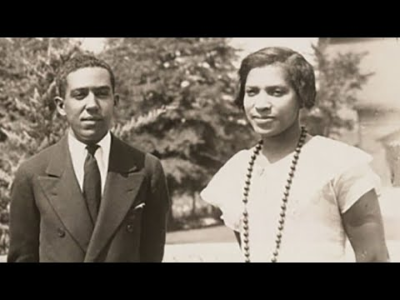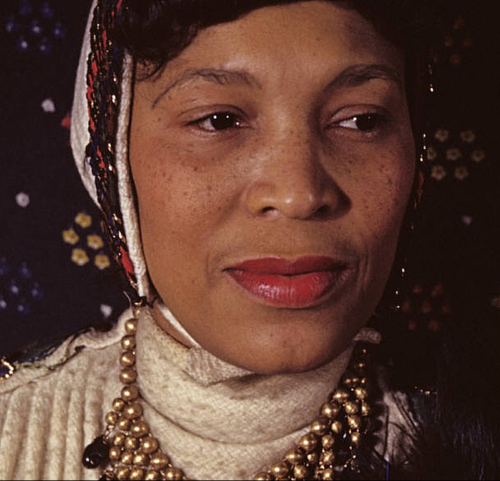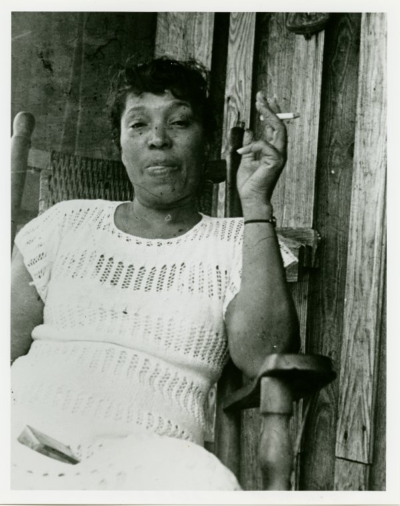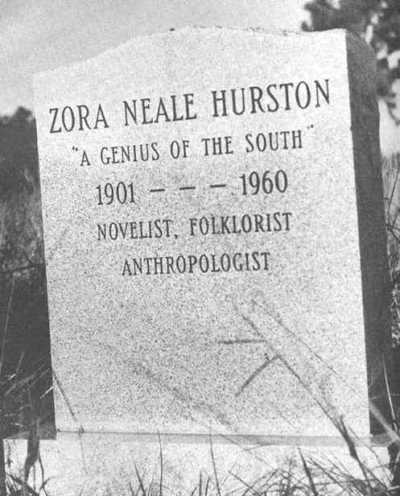The 85-year-old classic, Their Eyes Were Watching God by Zora Neale Hurston has been challenged throughout the years for reasons related to its raw honesty, realistic situations, and characters. Recently, I decided to revisit the seminal novel that I had never finished reading as a child.
Their Eyes Were Watching God is one of those books you feel you ought to love because it occupies such an iconic position in 20th-century literature. But as I began to read the novel, I remembered how difficult it had been for me to get past characters who sounded so ignorant and uneducated. Even though Hurston’s use of the vernacular gives the story authenticity, I found it challenging to get to grips with it and found myself having to re-read sentences to ensure I understood what was being said. Then, I was struck by the fact that I knew so little about Hurston. So, I felt compelled to familiarize myself with one of the most pre-eminent writers of the Harlem Renaissance.

Zora Neale Hurston was born on January 7, 1891, in Notasulga, Alabama. She was the fifth of eight children. Hurston’s father, John, was a Baptist preacher, and her mother, Lucy Potts, a school teacher. John was born into slavery; Lucy was born to freed slaves. The Hurston family moved in 1894 to Eatonville, Florida, the first town populated and governed by African Americans. Hurston grew up sheltered from racism in a town with an all-Black government and schools; it was so idyllic, there was no jail. Hurston’s father was elected Mayor of Eatonville in 1897 and remained so for three terms. He was also the minister of one of the two churches in town.
Hurston had a happy childhood and lived in an eight-room house surrounded by five acres of land. But life for a 13-year-old Hurston drastically changed when her mother passed away in 1904. Not long after his wife’s passing, John married Mattie Moge, a much younger woman who was rumored to have been his mistress. The union caused quite a stir in the community. Hurston, who disliked her stepmother immensely, was then sent to a Baptist boarding school in Jacksonville, Florida but wound up leaving when John failed to pay her tuition.
Hurston calls the period from 1904 to 1914 her “haunted years” because her life was so very dismal. Unfortunately, not many records exist from this period of her life, except that she moved to Jacksonville to live with her sister Sarah and brother Robert. Hurston learned that she was “a little colored girl” in Jacksonville. This desperate period ended when Hurston’s brother, who had become a practicing physician, invited her to care for his children in Nashville, Tennessee. When Robert did not encourage Hurston to attend high school, she ran off to become the personal maid to Miss M., a singer in a Gilbert and Sullivan troupe. During this same period, Hurston lied about her age, shaving off ten years to gain admission to high school. She maintained the lie about her age throughout her life.
After graduating from Morgan Academy in 1918, Hurston then attended Howard University. She pledged Zeta Phi Beta and co-founded the college paper, The Hilltop. Hurston joined a literary club sponsored by writer Alain Locke, who encouraged her to publish in Howard University journals. She met in poet Georgia Douglas Johnson’s literary salon, the New Negroes, who were intellectual leaders and artists in the Black community, and whose talents and aspirations, would fuel in the 20s the second great renaissance of African American culture. These writers–-Bruce Nugent, Jean Toomer, Alice Dunbar–Nelson, and Jessie Fauset, among others–would in the next decade become part of the core group of the Harlem Renaissance.
When Hurston met Charlotte Osgood Mason, a wealthy philanthropist whose controlling nature often caused conflict with her beneficiaries, her life would take a different turn. According to Hurston’s autobiography Dust Tracks On a Road, Mason insisted upon being called “Godmother” by the New Negroes and her financial backing came at a steep price. She had formerly been involved with the Black community through her donations to southern Black schools. At the height of the Harlem Renaissance, Mason became interested, both financially and personally with the development of New Negro artists.
According to Langston Hughes, Mason had in the twenties “discovered the New Negro and wanted to help him, not because she wanted to see the Black race excel, but because she saw African Americans as ‘America’s great link with the primitive.'” In order to get her fill of the primitive, Mason turned to Alain Locke, who furnished her with artists like Hurston who were capable of supplying evidence of “Black primitivism” in their work.
Mason agreed to finance Hurston’s folklore collecting expeditions, but she made several demands on the young artist. The text itself and all the material gathered by Hurston were to belong to Mason and had to have “primitive” elements. She made Hurston sign a contract that forbade her from publishing any material without her expressed permission. Eventually Hurston’s involvement with Mason proved confining. If Hurston’s tales failed to express the desired “primitive” element Mason wanted, she was denied support. By 1932, Hurston’s connection with the demanding patron was severed soon after she returned to New York from a trip.
To critics and intellectuals, as well as to many of her contemporaries, Hurston seemed to pander to the white pursuit of primitivism. Hurston and Hughes, who shared Mason as a patron, were never involved romantically. The writers did share a friendship for many years until they worked together to write the play Mule Bone: A Comedy of Negro Life (1931), and the collaboration ended their friendship.
Hughes described Hurston as follows… “In her youth, she was always getting scholarships and things from wealthy white people, some of whom simply paid her just to sit around and represent the Negro race for them.” Hurston “represented” her race to these white patrons through telling “side-splitting anecdotes, humorous tales, and tragicomic stories,” and by being to many of her white friends, a perfect darkie. That is a naïve, childlike, sweet, humorous, and highly colored Negro.”
Another instrumental person in Hurston’s life was Annie Nathan Meyer, a founder of Barnard College. Meyer met Hurston at an awards dinner, and by the night’s end she had offered the young writer a place at Barnard. Hurston dedicated her book, Mules and Men, to Meyer. In addition to being accepted into the prestigious college, Meyer saw to it that Hurston also receive a scholarship. Hurston was also the only Black student in attendance at the institution. Barnard provided another turning point for Hurston. She began to study anthropology with Franz Boas, the father of modern anthropology, who believed in the distinctive culture of African Americans. Boas urged Hurston to do fieldwork in her hometown, in order to preserve a heritage that was slipping away. Hurston earned her B.A in anthropology in 1928 and at age 37, she was the first Black person to graduate from Barnard.
Hurston did manage to make time for love. She married jazz musician Herbert Sheen in 1927 but the couple divorced just four years later.
Hurston soon moved into her peak creative period where she pursued fiction, drama, and anthropology simultaneously. She was awarded a Guggenheim Fellowship in March 1936 and was even able to travel to Jamaica and Haiti. Hurston published several short stories and articles as well as her novel Jonah’s Gourd Vine (1934), and Mules and Men (1935). She published her biggest seller Their Eyes were Watching God (1937). Hurston’s novel Tell My Horse (1938) was a first-hand account of the weird mysteries and horrors of voodoo. She also wrote Moses, Man of the Mountain (1939).
Hurston went down the aisle yet again in 1939. She married Albert Prince, who was 25 years younger. Unfortunately, the couple’s marriage lasted only seven months.
The luminary finally achieved some measure of critical acclaim after Hurston’s autobiography, Dust Tracks on a Road, was published in 1942, and six years later, the novel Seraph on the Suwanee was released. The very same year Seraph was published, a 10-year-old mentally challenged son of a former landlady accused Hurston of sodomy; she was arrested on morals charges. Hurston’s passport proved she was in Honduras at the time of the accusation. News of the charges was splashed across African–American tabloids. Hurston was so devastated that she even contemplated suicide. Six months after the accusation, Hurston was acquitted of all charges after the boy confessed that he had falsely accused her of the act. Hurston’s feelings of betrayal from the Black community, and the subsequent disgrace she faced, made her leave Harlem and head back south.
Throughout her career, Hurston had often been criticized as being deeply conservative and was reportedly prone to troubling, sometimes stereotypical assessments of her people. She understood societal racism but thought that part of overcoming was learning how to work the system rather than overturning it. She resisted the idea that her color should have made her feel differently. She was a staunch supporter of Senator Joseph McCarthy, the popular face of the Red Scare that followed WWII, even when other politicos, including President Dwight D. Eisenhower, thought he was a menace. She was in support of the Korean War, a military and diplomatic disaster. Hurston was also apathetic toward the unprovoked invasion of Ethiopia by the dictator Benito Mussolini in 1935. She also opposed the U.S. Supreme Court’s 1954 Brown v. Board of Education desegregation decision.
In a 1955 letter to the Orlando Sentinel newspaper, Hurston argued against desegregation for the sake of the self-respect of African Americans. She writes, “how much satisfaction can I get from a court order for somebody to associate with me who does not wish me near them?” In Hurston’s view, the decision was a forced interaction that only devalues Blacks, positioning White schools as “inherently better because they had White students.”
The brilliant writer continued to struggle to survive. Hurston found work as a freelance writer for magazines and newspapers, She also worked as a librarian, and substitute teacher but was fired from both jobs. She eventually had to work as a maid. The author’s literary fame did not bring her financial security. As a matter of fact, Hurston’s largest royalty was $943.75. The author of seven books, numerous short stories, and innumerable articles and essays passed into obscurity in her later years.
In 1958, Hurston’s health took a turn for the worse. After having had several strokes, Hurston was moved to a St. Lucie County welfare nursing home. She died on January 28, 1960, of hypertensive heart disease and was buried in an unmarked grave in Fort Pierce, Florida. After Hurston’s passing, her personal possessions were ordered to be burned. Police officer Patrick Duval, who was also Hurston’s friend, happened to pass by the house where she lived and put out the fire. He managed to save her invaluable collection of writings. The following year, Hurston’s friend and neighbor, Marjorie Silver, donated papers, which include letters, photographs, and even an unpublished manuscript, to the University of Florida libraries. The collection, about a thousand in total, has grown since then, with contributions from Hurston’s friends and colleagues.
In 1973, The Color Purple author Alice Walker and high school teacher, Charlotte D. Hunt, located what they believed to be Hurston’s caved-in, and overrun unmarked grave in a snake-infested wasteland of a graveyard in Ft. Pierce. Both women had an ongoing interest in the nearly forgotten African-American novelist and folklorist. Walker paid for a modest headstone to mark it; it was all she could afford at the time. Walker was certain they had found the right spot of Hurston’s grave, “There are times — and finding Zora’s grave was one of them — when normal responses of grief, horror, and so on, do not make sense because they bear no relation to the depth of emotion that one feels. It was impossible for me to cry when I saw the field full of weeds where Zora is. Partly this is because I have come to know Zora through her books and she was not a teary person herself; but partly, too, it is because there is a point at which even grief feels absurd.”
“Zora Neale Hurston: A Genius of the South” — The inscription that Alice Walker provided for the gravestone she erected says it all.
The legacy of Zora Neale Hurston continues in her hometown of Eatonville, Florida. First presented in 1990, the ZORA! Festival is an event composed of public talks, museum exhibitions, theatrical productions, arts education programming, and a 3-day outdoor festival of the arts. The event takes place primarily in Eatonville (10 miles north of Orlando) and throughout Orange County. Each year thousands upon thousands of Zora fans flock to the festival to celebrate the historical significance of one of the most dominant female voices of the Harlem Renaissance era.













